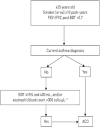Asthma-COPD overlap: identification and optimal treatment
- PMID: 30336736
- PMCID: PMC6196614
- DOI: 10.1177/1753466618805662
Asthma-COPD overlap: identification and optimal treatment
Abstract
Asthma and chronic obstructive pulmonary disease (COPD) are both highly prevalent conditions that can coexist in the same individual: the so-called 'asthma -COPD overlap' (ACO). Its prevalence and prognosis vary widely depending on how ACO is defined in each publication, the severity of bronchial obstruction of patients included and the treatment they are receiving. Although there is a lack of evidence about the biology of ACO, the overlap of both diseases should express a mixture of a Th1 inflammatory pattern (characteristic of COPD) and a Th2 signature (characteristic of asthma). In this review we support a novel algorithm for ACO diagnosis proposed by the Spanish Respiratory Society (SEPAR), based on a sequential evaluation that considers: (a) the presence of chronic airflow limitation in a smoker or ex-smoker patient ⩾35 years old; (b) a current diagnosis of asthma; and (c) the existence of a very positive bronchodilator test (PBT; ⩾15% and ⩾400 ml) or the presence of eosinophilia in blood (⩾300 eosinophils/μl). This algorithm can identify those patients who may benefit from a treatment with inhaled corticosteroids (ICSs) and maybe from biological drugs in a near future. In addition, it is easily applicable in clinical practice. The major disadvantage is that it groups patients with very different characteristics under the ACO's umbrella. In view of this heterogeneity, we recommend a strategy of defining specific and measurable therapeutic objectives for every single patient and identifying the traits that can be treated to achieve those objectives.
Keywords: COPD; asthma; asthma-COPD overlap.
Conflict of interest statement
Figures


Similar articles
-
Accuracy of a New Algorithm to Identify Asthma-COPD Overlap (ACO) Patients in a Cohort of Patients with Chronic Obstructive Airway Disease.Arch Bronconeumol (Engl Ed). 2018 Apr;54(4):198-204. doi: 10.1016/j.arbres.2017.10.007. Epub 2017 Dec 9. Arch Bronconeumol (Engl Ed). 2018. PMID: 29229474 English, Spanish.
-
Consensus on the Asthma-COPD Overlap Syndrome (ACOS) Between the Spanish COPD Guidelines (GesEPOC) and the Spanish Guidelines on the Management of Asthma (GEMA).Arch Bronconeumol. 2017 Aug;53(8):443-449. doi: 10.1016/j.arbres.2017.04.002. Epub 2017 May 8. Arch Bronconeumol. 2017. PMID: 28495077 English, Spanish.
-
Combination therapy of inhaled steroids and long-acting beta2-agonists in asthma-COPD overlap syndrome.Int J Chron Obstruct Pulmon Dis. 2016 Nov 8;11:2797-2803. doi: 10.2147/COPD.S114964. eCollection 2016. Int J Chron Obstruct Pulmon Dis. 2016. PMID: 27877033 Free PMC article.
-
LAMA/LABA vs ICS/LABA in the treatment of COPD in Japan based on the disease phenotypes.Int J Chron Obstruct Pulmon Dis. 2015 Jun 10;10:1093-102. doi: 10.2147/COPD.S72858. eCollection 2015. Int J Chron Obstruct Pulmon Dis. 2015. PMID: 26089659 Free PMC article. Review.
-
The asthma-chronic obstructive pulmonary disease overlap syndrome (ACOS): opportunities and challenges.Curr Opin Pulm Med. 2015 Jan;21(1):74-9. doi: 10.1097/MCP.0000000000000118. Curr Opin Pulm Med. 2015. PMID: 25405671 Review.
Cited by
-
Blood Eosinophil Endotypes across Asthma and Chronic Obstructive Pulmonary Disease (COPD).Can Respir J. 2022 Oct 19;2022:9656278. doi: 10.1155/2022/9656278. eCollection 2022. Can Respir J. 2022. PMID: 36311545 Free PMC article.
-
The Interactome of Protein, DNA, and RNA.Methods Mol Biol. 2023;2695:89-110. doi: 10.1007/978-1-0716-3346-5_6. Methods Mol Biol. 2023. PMID: 37450113 Review.
-
Pulmonary function testing in COPD: looking beyond the curtain of FEV1.NPJ Prim Care Respir Med. 2021 May 7;31(1):23. doi: 10.1038/s41533-021-00236-w. NPJ Prim Care Respir Med. 2021. PMID: 33963190 Free PMC article. Review.
-
Magnesium sulfate for acute exacerbations of chronic obstructive pulmonary disease.Cochrane Database Syst Rev. 2022 May 26;5(5):CD013506. doi: 10.1002/14651858.CD013506.pub2. Cochrane Database Syst Rev. 2022. PMID: 35616126 Free PMC article.
-
Chronic obstructive pulmonary disease classification, phenotypes and risk assessment.J Thorac Dis. 2019 Sep;11(Suppl 14):S1761-S1766. doi: 10.21037/jtd.2019.05.10. J Thorac Dis. 2019. PMID: 31632753 Free PMC article. Review.
References
-
- Burrows B, Bloom JW, Traver GA, et al. The course and prognosis of different forms of chronic airways obstruction in a sample from the general population. N Engl J Med 1987; 317: 1309–1314. - PubMed
-
- Postma DS, Weiss ST, van den Berge M, et al. Revisiting the Dutch hypothesis. J Allergy Clin Immunol 2015; 136: 521–529. - PubMed
-
- Bui DS, Lodge CJ, Burgess JA, et al. Childhood predictors of lung function trajectories and future COPD risk: a prospective cohort study from the first to the sixth decade of life. Lancet Respir Med 2018; 6: 535–544. - PubMed
-
- Papi A, Romagnoli M, Baraldo S, et al. Partial reversibility of airflow limitation and increased exhaled NO and sputum eosinophilia in chronic obstructive pulmonary disease. Am J Respir Crit Care Med 2000; 162: 1773–1777. - PubMed
Publication types
MeSH terms
Substances
LinkOut - more resources
Full Text Sources
Medical

